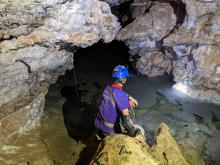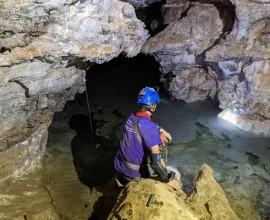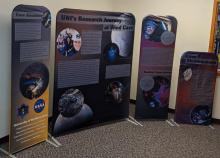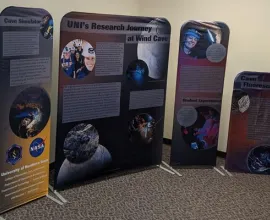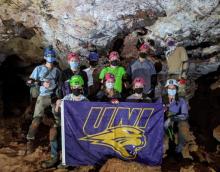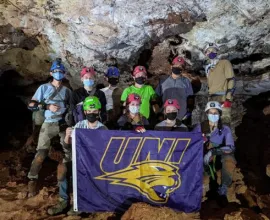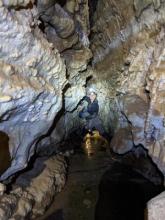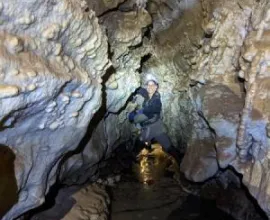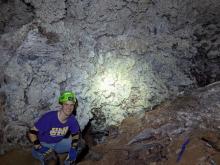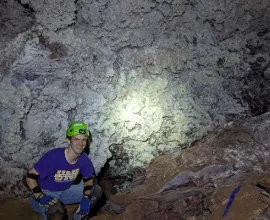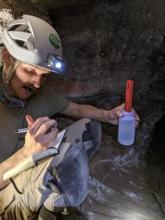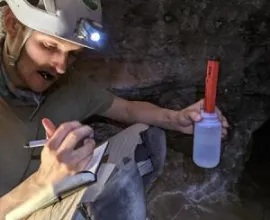NASA-Iowa Space Grant Consortium - Wind Cave Research
Wind Cave as a Terrestrial Analog for Possible Exobiological Environments off Earth
NASA-Iowa Space Grant Consortium (ISGC) Grant
Wind Cave National Park, South Dakota
As a part of a $200,000 grant from NASA and the Iowa Space Grant Consortium (ISGC), a team of investigators from across the university is studying the types of isolated life that can survive in extreme subterranean systems such as those found in Wind Cave National Park, South Dakota. From this work, they hope to develop an understanding of the conditions that allow life to grow in such places and use it as a method of understanding how similar environments might exist and behave beyond the Earth.
As a part of a $200,000 grant from NASA and the Iowa Space Grant Consortium (ISGC), a team of investigators from across the university is studying the types of isolated life that can survive in extreme subterranean systems such as those found in Wind Cave National Park, South Dakota. From this work, they hope to develop an understanding of the conditions that allow life to grow in such places and use it as a method of understanding how similar environments might exist and behave beyond the Earth.
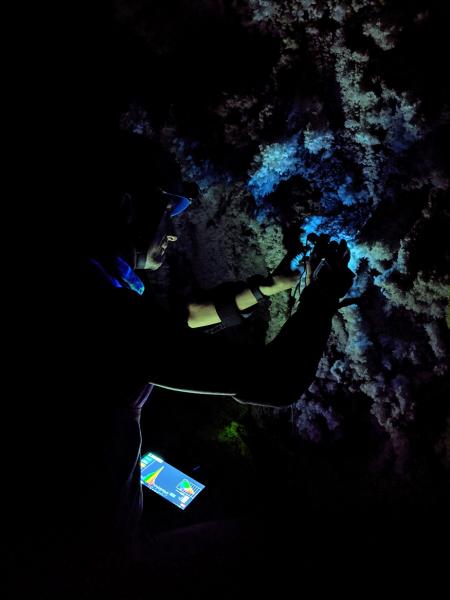 Faculty from 4 departments across UNI have teamed with collaborators at NASA’s Jet Propulsion Laboratory (JPL) and Goddard Space Flight Center (GSFC) to undertake three targeted projects and the creation of related digital media for public education. Dr. Justin Peters, Chemistry & Biochemistry, and Dr. Marek Sliwinski, Biology, are creating a genetic map of the Wind Cave microbial system including the surface prairie, public tour routes, and the deep wild cave regions that includes extreme subterranean lake environments. Dr. Joshua Sebree, Chemistry & Biochemistry, and Dr. Kenneth Elgersma, Biology, are following the flow of carbon from the prairie surface to these lake districts, tracing these compounds in an attempt to connect the flow of organic carbon from the surface to the subterranean environment. Dr. Mohammad Iqbal, Earth & Environmental Science, is leading the investigation into determining the composition and source of the water in these subterranean lakes and what impact that has for how this life establishes itself and grows. And Dr. Francesca Soans, Communication & Media, is facilitating the creation of several science documentaries for the public based on the results of this research.
Faculty from 4 departments across UNI have teamed with collaborators at NASA’s Jet Propulsion Laboratory (JPL) and Goddard Space Flight Center (GSFC) to undertake three targeted projects and the creation of related digital media for public education. Dr. Justin Peters, Chemistry & Biochemistry, and Dr. Marek Sliwinski, Biology, are creating a genetic map of the Wind Cave microbial system including the surface prairie, public tour routes, and the deep wild cave regions that includes extreme subterranean lake environments. Dr. Joshua Sebree, Chemistry & Biochemistry, and Dr. Kenneth Elgersma, Biology, are following the flow of carbon from the prairie surface to these lake districts, tracing these compounds in an attempt to connect the flow of organic carbon from the surface to the subterranean environment. Dr. Mohammad Iqbal, Earth & Environmental Science, is leading the investigation into determining the composition and source of the water in these subterranean lakes and what impact that has for how this life establishes itself and grows. And Dr. Francesca Soans, Communication & Media, is facilitating the creation of several science documentaries for the public based on the results of this research.
Key to all aspects of this project is the involvement of UNI undergraduate students. Teams are visiting the Wind Cave National Park site with faculty investigators multiple times each year. Working alongside both faculty as well as NASA scientists and visiting NASA research centers, students are being given the opportunity to participate in advanced field work while also presenting at both local and national conferences. And a student media team has been filming the lab science and Wind Cave expeditions for annual public release as a part of the UNI at Wind Cave museum exhibit currently on display at Wind Cave National Park.
For an in-depth profile of student engagement with the Wind Cave research project, please visit https://insideuni.uni.edu/stem/discovery-lifetime.
This project/material is based upon work supported by the Iowa Space Grant Consortium under NASA Award No. 80NSSC20M0107.
UNI at Wind Cave National Park - Image Gallery
Below find images from the latest research trip (Summer 2021) to Wind Cave with Dr. Joshua Sebree and a group of student researchers. According to park staff, their team is one of only 3 groups that do research at Wind Cave National Park. Midway through this latest trip, they have already logged close to 12 miles in the wild areas of the cave system in search of extreme life forms. Less than 50 people have ever explored this deeply!

